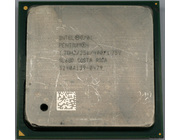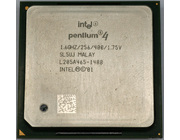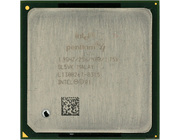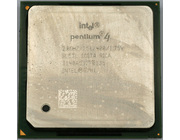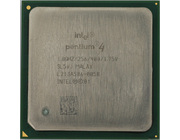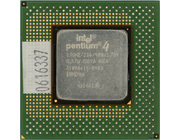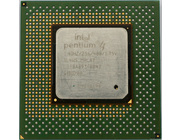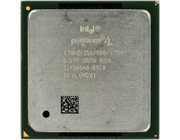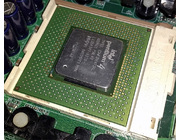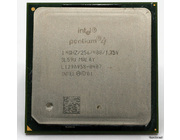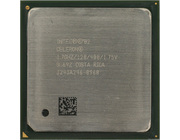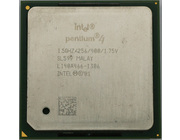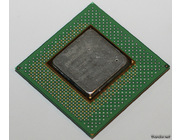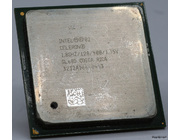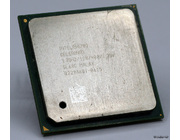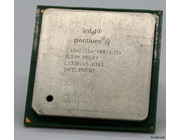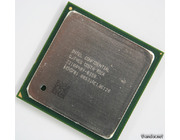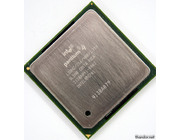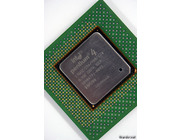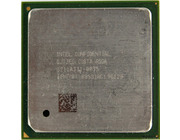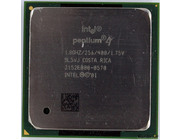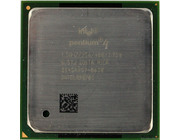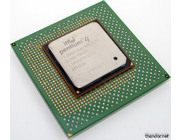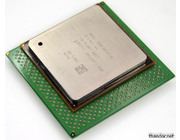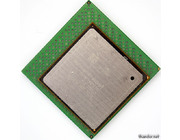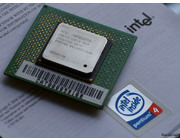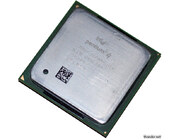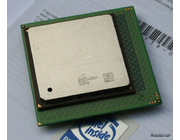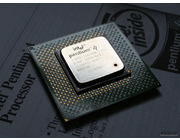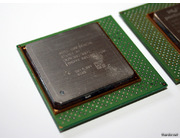Willamette is the codename for the first Pentium 4. In 1998, when the Pentium II was new, Intel started developing the Netburst microarchitecture with 1GHz as target clock frequency. The oldest Pentium 4 I've seen can be found here and, as far as I know, first working samples of the Pentium 4 is the QT69ES.
On 20 November 2000, Intel released the Pentium 4 at 1.4 and 1.5GHz. It was an expensive chip and it needed expensive Rambus (RDRAM) memory in order to operate. Motherboards with the slow but cheap SDR-SDRAM (which caused a performance hit for bandwidth hungry the Pentium 4) came later. The introduction of the SDR-SDRAM capable motherboards caused the Pentium 4's sales to increase a lot. The Pentium 4 Willamette came in versions ranging from 1.3GHz to 2.0GHz. Budget versions, the Celeron, had 128KB L2 cache instead of 256KB L2 cache. Willemette was launched using the S423-socket but was later available for the S478-socket, just like the newer Pentium 4 Northwood.
Willamette did not perform very good, but paired up with RDRAM it's performance was not bad. AMD could offer a much cheaper Athlon (Thunderbird) which performed just as good.
New features in the Willamette were SSE2 instructions and clock-throttling. The latter made the processor run slower in case it started to overheat. In case of a fan-failure the processor won't be damaged.
The first Pentium 4 CPU's were based on the Willamette-core and ranged from 1.3GHz to 2.0GHz. The first series all made use of socket 423 but it didn't take long for Intel to start with socket 478. I guess most people associate 478 with the much better 130nm Northwood-core but both Willamette and the newer Prescott core found it's way on the 478 platform. So did this 1.9GHz Pentium 4, too ![]() . > Read more
. > Read more
Intel launched the Pentium 4 Willamette on November 20, 2000 at 1.4GHz and 1.5GHz. The CPU that would be next in line was the, even slower, 1.3GHz in early 2001. It wasn't until April 23, 2001 for Intel to release the 1.7GHz version. Finally a CPU that was really (overall) faster than it's predecessor Pentium III and could compete with an Athlon 1400 DDR. > Read more
Clocked at 1400MHz just like this Pentium 4 1.4GHz. The difference is that this one has been made in the 18th week of 2001 and is based on the C1 core. The other Pentium 4 1.4GHz I have is manufacture before the official launch date and uses the earlier B2 core. > Read more
An engineering sample of the second fastest 'Willamette' based Pentium 4. The 2GHz would be the top-of-the-line model that would set you back $562. That is $187 more than the 1.9GHz model. A nice premium for that extra 100MHz ![]() .
.
On the S423 platform you can go beyond 2GHz by using PowerLeap adapters that, if your motherboard supports it, allow you to run Northwood CPU's. > Read more
The slowest official Pentium 4 for S478 socket. It was launched together with the faster models up to 2GHz.
In the wild these 1400MHz is an uncommon CPU. Usually the 1400MHz parts are made to fit the older S423 and it seems that faster models (1,5 to 2,0GHz) were sold more. Especially 1.6, 1.7 and 1.8GHz models. > Read more
Just like this Pentium 4 1.3GHz but with a different sSpec number. > Read more
As opposed of this Celeron 1.8, this one is a normal production version. > Read more
Just a Celeron at 1700MHz; not much spectacular and perfomance wise. Perhaps only interesting for Office applications. > Read more
Easily overshadowed by AMD's Athlon and Athlon XP processors. The Willamette was not much of a performance king, especially when fitted with slow (but cheap) SDR-SDRAM. Something that happenend a lot in cheap home use systems. > Read more
A very late Intel Celeron 1.8GHz engineering sample. The Willamette core was released in 2000 and this sample, with the last Willamette-revision (E0) is from 2002! > Read more
Like this Pentium 4 1500 but with a different sSpec number and a Willamette core with C1 stepping. > Read more
Because I have both the 1300MHz and 1500MHz Pentium 4 for socket 423 the 1400MHz model seems like a nice addition. At the time Intel released these CPU's in November 2000 only the 1400MHz and 1500MHz models were released.
Interesting to see is that this CPU has been made in week 40 of 2000 which dates back to the first week of October 2000. In my agenda October is the 10th month and November the 11th meaning this CPU has been made, for production market, one month before it's release. > Read more
An engineering sample of a not-so-very-speedy Celeron. This Celeron is based on the same core as the Pentium 4 Willamette but only has 128KB L2-cache instead of 256KB L2-cache. Because the 'Netburst' architecture has a long pipeline a big L2-cache is useful and this CPU doesn't have a big L2-cache; you do the math.
Because my i865G platform doesn't recognise this CPU as a 1900MHz Celeron but 1700MHz I don't have benchmarks yet. > Read more
100MHz faster than this Pentium 4 but technically the same. > Read more
Pretty much like this Pentium 4 except that the socket is different. This model is for S478 which is also available for Northwood and Prescott CPU's. > Read more
The slowest production Pentium 4 'Willamette'. The Pentium 4 was released at frequencies starting at 1400MHz/1500MHz but Intel decided to ship 1300MHz parts afterwards in early 2001.
In my opinion the Pentium 4 1.3GHz wasn't really justifiable. It was slower than the existing Pentium III and the competing Athlon's but in the early days the Pentium 4 platform (motherboard, RAMBUS memory) was way to expensive for a CPU with such little power.
This particular CPU is from week 1 of 2001. That is the exact week when the 1.3GHz part was officially launched ![]() . > Read more
. > Read more
My third QT69ES CPU. This one is like this 1.x GHz CPU but has a different production date. It is 2 weeks newer so I wonder if there is any difference (with overclocking for example) between the two. > Read more
This one is the same as this Pentium 4 1.xGHz except for the fact that this one is not working. It misses some pins and the heatsink is quite scratched. > Read more
My third 1.5GHz Intel Pentium 4 CPU. This one is practically the same as this 1.5GHz CPU except for the fact that we are dealing with an Engineering Sample. Benchmarking this CPU would be useless as scores are identical to the 1500MHz Willamette in the given link.
This CPU does work but turned out to be less compatible with my MSI 850 Pro2 motherboard and has technical problems. With difficulties I could get it running at only 800MHz (8x100) instead of the full 1500MHz. I booted it at 1500MHz once but highly unstable. Booting Microsoft Windows 2000 SP4 didn't work quite well, I got an 'hard error' at the time the desktop should pop up. In the BIOS I noticed the CPU temperature was 0C. It got the correct values when I pushed somewhere on the heatspreader. For testing purposes I grabbed an Intel Desktop Board with i850 chipset of the shelf to give it a go. Now it booted up at 1500MHz at once ![]() . I didn't bother installing the Intel Desktop Board into my PC and install everything so no CPUz screenshot or whatsoever.
. I didn't bother installing the Intel Desktop Board into my PC and install everything so no CPUz screenshot or whatsoever.
In this case the Intel Desktop Board turned out to be the solution to get this CPU running properly. But beware that the board doesn't support multipliers lower then 12x. Running CPU's like the QT69ES is not advisable as you would 'overclock' (in case that's possible with an unrated CPU) it to 1200MHz which is most likely to fail. Not to mention you're stressing up the old chip to the maximum (at the day I figured that the board didn't go for low multipliers my QT69ES booted up once, after many tries and not hoping the CPU was defect, at 1200MHz). > Read more
A one-of-million S478 CPU. Nothing new, nothing special ![]() .
.
This CPU is perfect for filling up the gap between 1.5A GHz 'Northwood', 1.5 GHz Willamette and 2.0A GHz 'Northwood'. The 1.5GHz Willamette will run with 800MHz RIMM's; this 1700MHz S478 is tested with Single Channel DDR (on i845G) and Dual Channel DDR (on i865G).
As we all know Intel's 'Netburst'-micro architecture adores lot's of memory bandwidth. It won't surprise anyone that a Dual Channel DDR setup will be faster then Single Channel. But what about, expensive, 800MHz RIMM's? > Read more
Not much known about this CPU but it might be the first S423 CPU out there! Unfortunatly it does not work so it's all guessing what it would be.
Using my home and kitchen plate I measured a 39 gram for this CPU. It's brother QT69ES, a newer working sample, was 40 gram. The difference might be smaller then 1 gram as the plate is not that precise. Despite that it's safe to assume this CPU has the guts and thus a Willamette core in it.
The CPU fits easily along in the socket but doesn't get warm. Neither the board seems to be able to do anything with the CPU. The indicator leds on the MSI 850 Pro2 stay red instead of turning into green.
The CPU has very few markings on the heatspreader. This makes it difficult to name it (there is no sSpec number for example). On the heatspreader I only read 'D9356087' and '0090' along with an indentifier pattern. > Read more
The first retail Pentium 4's ran at 1,4GHz and 1,5GHz and were released in November 2000. This CPU is made in the 16th week of 2001. > Read more
An early but working Intel Pentium 4 A2-stepping processor. This model carries the name 'Intel Pentium 4 1.x GHz' but is often referred to as the 800MHz Pentium 4. At the time Intel made this processor it was unclear how fast it could run. The target was probably around 1GHz but because of the unlocked multiplier the CPU boots up using the lowest multiplier, which is 8x.
In 1998, when the Intel Pentium II and AMD K6/2 were brandnew, Intel started developing the 'Netburst' micro architecture. Due to delays the first retail CPU was released in November 2000. This engineering sample with sSpec number 'QT69ES' was made in the 17th week of 2000.
The 'Netburst' micro architecture was a brand new design but was not so speedy at all. The AMD Athlon 'Thunderbird' and even the old Intel Pentium !!! 'Coppermine' was actually faster! A 1GHz Athlon or Pentium !!! outperforms a 1GHz Willamette with ease and as since the first retail Intel Pentium 4 hit the shelves with only 1,4GHz and 1,5GHz it was no wonder the 1200MHz Athlon was able to compete. Especially in price/performance as the Intel Pentium 4 used (and needed for performance, models with SDR-SDRAM are slow) expensive RD-RAM while the Athlon ran happily with DDR-SDRAM.
Interesting notes regarding my 1.xGHz engineering sample: it has a fully unlocked multiplier which is not often found on Pentium 4 engineering samples. The heatspreader is different comparing to a regular S432 Willamette. The CPU is not quite able to run at high clock frequencies or high temperatures and despite the low clock frequency and low core voltage it runs quite hot. It goes to 50C with ease and the chip will probably crash when it's 60C! The chip also lacks a CPU string which means that software can't tell which CPU exactly fits into the system. When setting a regular Pentium 4 1,5GHz to 1,6GHz it would still show 1,5GHz in the string; this CPU will show the actual frequency.
Older Pentium 4's do exist but as far as I'm aware of they are non-functional. Check out this S423 CPU. It looks pretty much the same. Slightly different PCB and very few markings on the heatspreader.
> Read more
